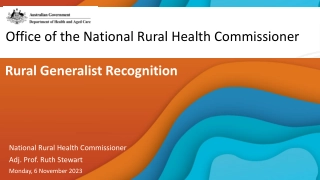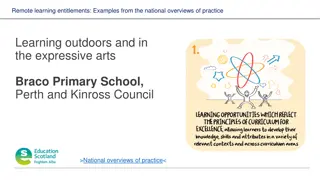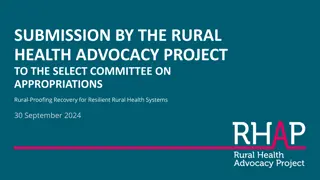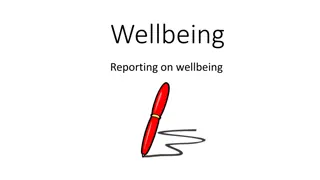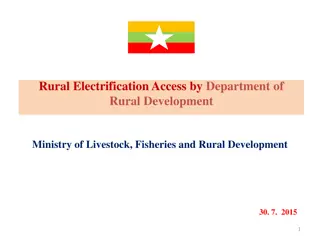Enhancing Farmer Wellbeing in Rural and Remote Areas
Addressing the importance of farmer wellbeing, this content discusses factors influencing wellbeing, the social determinants, and the occupational drivers affecting farmers in rural and remote regions. Strategies for improving mental health and overall wellbeing are explored to support farmers in achieving better outcomes and enhancing the health of the land and community.
Download Presentation

Please find below an Image/Link to download the presentation.
The content on the website is provided AS IS for your information and personal use only. It may not be sold, licensed, or shared on other websites without obtaining consent from the author.If you encounter any issues during the download, it is possible that the publisher has removed the file from their server.
You are allowed to download the files provided on this website for personal or commercial use, subject to the condition that they are used lawfully. All files are the property of their respective owners.
The content on the website is provided AS IS for your information and personal use only. It may not be sold, licensed, or shared on other websites without obtaining consent from the author.
E N D
Presentation Transcript
REGENERATIVE FARMING HEALTHY LAND, HEALTHY PROFITS, HEALTHY PEOPLE 6thRural and Remote Health Scientific Symposium Kimberly Brown1, Dr Jacki Schirmer1,2, Sue Ogilvy3and Mark Gardner4 Health Research Institute1& Institute for Applied Ecology2 University of Canberra Fenner School of Environment & Society, Australian National University3 Vanguard Business Services4
Addressing Farmer wellbeing Most activities addressing farmer mental health focus on early intervention and access to treatment Further investigation on promotion and prevention activities targeting this group is required What can be done to help improve wellbeing? Mental health intervention spectrum. Adapted from Institute of Medicine (1994, Fig 2.1, p 23)
WHY IS WELLBEING IMPORTANT? Social determinants of wellbeing Smoking, drinking, exercise Social interaction Safety of community Access to services and infrastructure (education, health, internet, mobile phone) Environmental health Landscape (physical and natural) Age Gender Life experiences Wellbeing: a state in which every individual realizes his or her own potential, can cope with the normal stresses of life, can work productively and fruitfully, and is able to make a contribution to her or his community World Health Organization, 2013
FACTORS KNOWN TO INFLUENCE YOUR WELLBEING Determinants of rural and remote wellbeing Access to health services (and willingness to access them) Isolation/remoteness Determinants of farmer wellbeing Conditions on the farm - weather/climate, pest/disease, input costs, market change, regulatory change, others .. Ability to achieve desired outcomes on farm (confidence in your skills, ability to overcome challenges and able to achieve positive outcomes) Working conditions working hours, isolation, family relationships, physical injury Fraser, Smith, Judd, Humphreys, Frager & Henderson (2005) and Soosai-Nathan & Delle Fave (2016)
WHAT CAN WE DO TO ADDRESS THE OCCUPATIONAL DRIVERS OF FARMER WELLBEING? Photo taken by Natasha Peasley
WHAT IS REGENERATIVE FARMING? A type of agriculture that aims to restore balance in ecological systems through a whole of farm approach. At least 5,000 regenerative farms in Australia (depending on your definition) Regenerative farming is characterised by a focus on: - Increasing biodiversity - Maintaining groundcover - Incorporation of farming systems into existing natural systems - Increasing the organic matter in soils - Monitoring the regeneration of the landscape - Reducing reliance on inputs Photo courtesy of David Marsh, regenerative farmer near Boorowa
WELLBEING CLAIMS Less stress and worry Improved relationships social connectedness Drought preparedness and resilience Improved self- efficacy Increased financial security and stability Very little evidence to support these claims
PROJECT AIM To explore the health and wellbeing outcomes for regenerative farmers - This project is jointly funded through University of Canberra and the Australian Government s National Environmental Science Program. - Led by the Fenner School at ANU - A multidisciplinary project exploring ecological, economic and wellbeing benefits associated with regenerative farming - University of Canberra conducted the wellbeing component
STUDY DESIGN Mixed methods approach Exploratory study To inform future research using larger samples Taken a small group of Best Practice Regenerative Farmers, and compared their wellbeing to other groups of farmers Semi-structured interviews: Explored the impact regenerative farming had on wellbeing and wellbeing determinants Thematic analysis of notes from interviews Results to help interpret findings from survey data analysis Analysis of survey data: Subjective wellbeing measures (life satisfaction, Personal Wellbeing Index, worthwhileness) Wellbeing determinants (farmer specific measures of self-efficacy) Controls (age those over 65 are much happier, gender complex differences)
SAMPLE Best practice regenerative farmers - Small sample, specifically selected (n=9) - NSW - Commercial scale graziers - Mostly male, almost all 40-60, almost all graziers - Completed both semi-structured interviews and wellbeing survey
SAMPLE CRITERIA BEST PRACTICE REGENERATIVE FARMERS 1. Property planning and management should include a long- term vision which considers the whole of the property and its place in the catchment 2. Manage soils to prevent erosion, maintain productive capacity and water quality (<30% bare soil surface) 3. Maintain a variety of plants and animals (presence of large native tussock grasses, <30% property high input area) 4. Maintain local trees (>30% property woodland/forest, with each patch >=10ha. Presence of mature, dead and naturally regenerating trees) 5. Core conservation areas at least 10% of the property 6. Presence of water courses and riparian areas that are covered in good quality native vegetation Photo courtesy of Rachel Lawrence 2017 Box gum grassy woodland Source: Principles of Managing and Conserving Grassy Woodlands (S. McIntyre, JG. McIvor, KM Heard 2002)
SAMPLE CRITERIA COMPARISON GROUP - - Completed the Regional Wellbeing Survey 2016 An annual survey of rural and regional Australia. Intensive sampling of farmers. Collates data on a range of wellbeing measures, and factors which influence the wellbeing of regional and remote Australia NSW Full-time grazier Male Aged 40 to 60 years Provided data for quantitative measures of wellbeing - - - - -
RESULTS Qualitative
FINDINGS QUALITATIVE INTERVIEWS Wellbeing benefits of regenerative agriculture Feeling good Optimism Reduced stress/worry Increased awareness of health Pride and enjoyment from the landscape Self-efficacy Improved on-farm decision making Pro-active rather than reactive Not reliant solely on external factors Monitoring and understanding the landscape Open to new ideas Financial stability Increased financial resilience of farming business Reduced financial burden Relationships Reduced hours worked on farm (most but not all) Time off farm Social connectedness (positive and negative) Improved family relationships
RESULTS Quantitative
Average subjective wellbeing of best practice regenerative graziers and comparison group Best practice regenerative graziers (n=9) 90.0 Full-time NSW graziers, aged 40 - 60, Male, 2017 (n=46,51) 85.0 84.4 80.0 80.9 75.0 76.7 76.1 75.6 75.5 70.0 65.0 Personal Wellbeing Index Satisfaction with life as a whole Feeling that life is worthwhile Subjective wellbeing - three measures. Each is measured from 0-100. In a sample of 100 or more differences of >3 points often meaningful & significant.
Average score satisfaction across various domains of life. BPRF and comparison group Best practice regenerative graziers (n=9) Full-time NSW graziers, aged 40 - 60, Male, 2017 (n=51) 8.5 8.6 8.0 8.0 7.9 7.8 7.5 7.6 7.6 7.6 7.6 7.4 7.3 7.3 7.3 7.0 7.0 6.9 6.5 Standard of living Health Achieving in life Personal relationships How safe you feel Feeling part of your community Future security Personal Wellbeing Index - individual items. Each is measured from 0-10. In samples of 100 or more differences of >0.4 points often meaningful & significant.
Average score measures of farmer self-efficacy. BPRF and comparison group Best practice regenerative graziers (n=9) Full-time NSW graziers, aged 40 - 60, Male, 2017 (n=51) 7.0 6.5 6.0 5.9 5.9 5.5 5.7 5.3 5.3 5.0 5.2 5.0 4.9 4.5 4.0 CONF achieve the things I want on my farm CONF meet my farm business objectives CONF make the right decisions about farm mgt CONF handle changing market cond. on my farm Average score, measured from 1 = strongly disagree to 7 = strongly agree. In samples of 100 or more differences of 0.5 points or more typically significant.
Average score measures of farmer self-efficacy. BPRF and comparison group Best practice regenerative graziers (n=9) Full-time NSW graziers, aged 40 - 60, Male, 2017 (n=51) 7.0 6.5 6.6 6.4 6.0 5.5 5.6 5.5 5.3 5.0 4.5 4.4 4.0 CONF I can cope well with most difficult conditions on the farm CONF maintain and improve the health of the vegetation, land and water on my farm I feel optimistic about my farming future Average score, measured from 1 = strongly disagree to 7 = strongly agree. In samples of 100 or more differences of 0.5 points or more typically significant.
FINDINGS Those practicing regenerative farming have higher eudaimonic wellbeing when compared with other farmers of similar farm type, age and gender Regenerative farmers scored much higher on measures of farmer self-efficacy (coping and optimism) This was also reflected in the qualitative data where regenerative farmers identified self- efficacy and self-improvement (determinants of eudaimonic wellbeing) as potential pathways for wellbeing Regenerative farmers were less satisfied with feeling part of their community Some farmers interviewed viewed practicing regenerative agriculture was in conflict with what is normally accepted as farming practice Regenerative farmers were more satisfied with their health compared to other farmers Farmers spoke about the importance of physical health in interviews, particularly in relation to diet and physical activity
LIMITATIONS & RECOMMENDATIONS Small sample size of best practice regenerative farmers Cross-sectional data Are those who choose to practice regenerative agriculture already healthier and happier? A study with a larger sample of regenerative farmers is required to determine if findings are replicated This small study shows there may be some association between regenerative agriculture and occupational drivers for farmer wellbeing, however more work is required to understand how we can better target these occupational drivers of farmer wellbeing This will require collaboration between the agricultural/natural resource management sector, and the health sector
THANK YOU Kimberly Brown PhD Candidate University of Canberra Centre for Research and Action in Public Health kimberly.brown@canberra.edu.au


